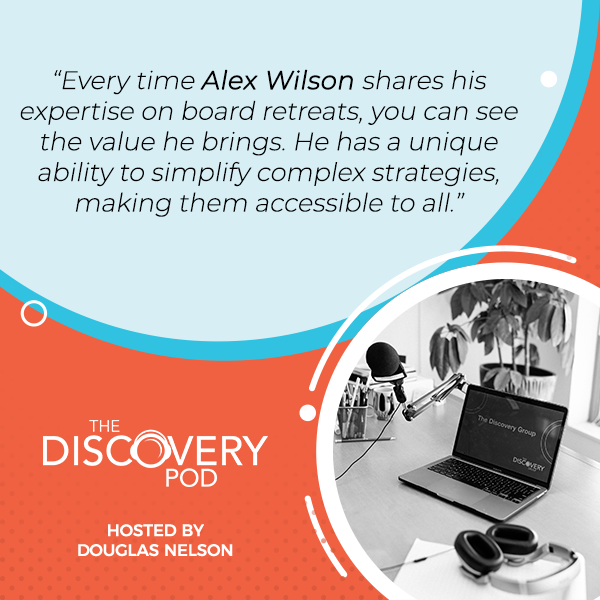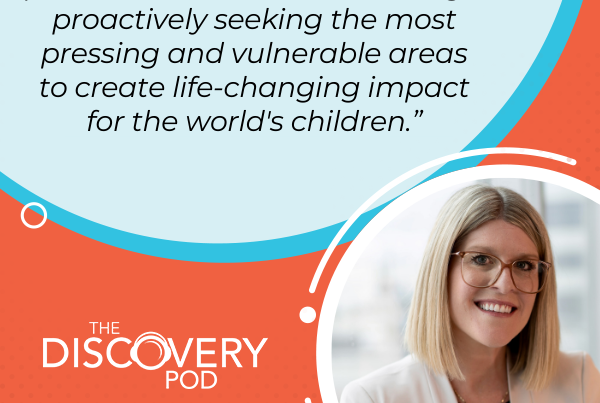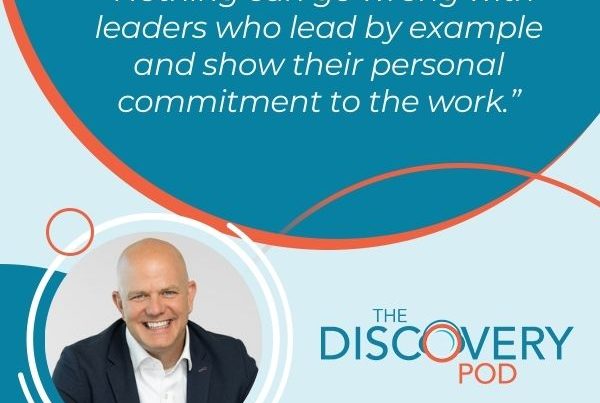
In this episode, Douglas Nelson sits down with Alex Wilson to explore the ins and outs of board retreat planning. Whether you’re a CEO preparing for your first retreat or a board member seeking insights on making these events more effective, this conversation offers valuable advice and practical tips. Douglas and Alex share their experiences and strategies to ensure your next board retreat is not only successful but also sets the stage for a productive year ahead. Tune in to discover how to plan, execute, and follow up on a board retreat that drives real results.
—
Listen to the episode here
Season 9 Opener: Planning An Effective Board Retreat With Douglas Nelson & Alex Wilson
Introduction To Strategic Board Retreats
Welcome to the show. Conversations with social profit leaders. We’re taking a deep dive into what it takes to plan and execute a successful, engaging, strategic board retreat. I’m joined by my colleague, Alex Wilson, our director of communications and executive producer of the show. Now, if you’re a CEO responsible for a retreat, a board member who will be attending one, or just someone who’s board retreat curious, who wants to see behind the scenes of how an effective one is put together, then this is a conversation you don’t want to miss. Welcome to the show, Alex.
Thanks, Doug. It’s great to be back and play host once again. I really hope all our listeners had a restful summer. I know we had a bit of a restful summer and are energized to tackle the fall, which is a busy time for everyone in our sector. One of the things that makes fall such a hectic but productive time is board retreats, as we all know. We’re going to do a deep dive into the details of planning an effective board retreat.
Cannot wait, it’s going to be great.
Doug, I know when it comes to board retreats, you’ve been on all three sides of the table as CEO, board member, and facilitator. How do you measure the success of a board retreat?
Three Key Questions For Effective Retreats
When working with board chairs and with CEOs on planning a board retreat, we start with three questions. Three questions plus a bonus question. The first is, what do you need the board members to know? What do you need them to decide, if anything? What seeds do you need to plant for conversations that are going to happen over the course of the year or in the years ahead?
That bonus question is, is there anything you need the board to stop doing? If you answer those three questions plus that bonus question, you’re going to come up with what you need to talk about. What information do you need to provide in advance? What decisions you may or may not need to make? How you’re going to look forward to using the momentum of the retreat, the good feeling at the end of that day to carry you through the whole board year and beyond.
I like that bonus question.
Normally when you first ask a CEO and the board chair that bonus question, what do you need the board to stop doing? There’s a quiet pause. Some think, there’s not really anything. Maybe, and often what we hear in an answer to that question of what do we need the board to stop doing? It reveals that zombie issue. You and I’ve talked about this before on the show, those zombie issues are the ones around the board table or in the boardroom that you think as management or even as chair, you think that this issue has been put to bed.

Board Retreat: Zombie issues can derail even the best-laid plans. Bury them before they rise during your board retreat.
It’s been put into the ground. We don’t have to deal with it anymore. Then somehow, just before the cookies come out at 1:30 or 2:00 in the afternoon, the board retreat day, these issues, these zombies come rising up out of the ground and present themselves fresh and new and wanting to be reconsidered by some or all members of the board. Being really clear about what those zombie issues are, knowing what those zombie issues are, and leading out that the day ahead, the retreat is not going to be a time for a visit to those zombie issues, those potential zombie issues.
Making it clear to the board members what you are going to talk about, and being confident enough in the agenda that you put together, that you can rule out or say, “Here are things we are not going to talk about during our time together at this board retreat.” It is the clearer you can be with what you’re expecting and the conversations you’re expecting the board members to have, the more effective the board retreat is going to be. The clearer you are in what you do want to talk about, it is going to give you that permission, that license to say to the board. Here are the 1 or 2 things we are not going to talk about. If you are afraid of those zombie issues, be confident in your agenda and rule out those things that do not fit the agenda that may come rising up out of the ground like Jason.
That’s great advice. Bury the zombie issues before the retreat. Many CEOs, especially first-time CEOs are often apprehensive going into the retreat. What do you remember from your first board retreat as CEO and what advice would have you given yourself if you could go back in time with the knowledge that you have now?
First of all, I think what I remember most is that feeling of blood rushing in my head and being able to hear that more than anything else in the conversation in the room. One of the biggest things that I think CEOs, new or veteran CEOs, need to remember is you are not a participant in the board retreat. If you’re a board chair, you’re not a participant either.
You’re the convener. In some cases, you’re the ringmaster of the circus but you are there to facilitate and convene an effective conversation to move the board through the issues and the areas that need to be covered in that board retreat in your very clearly laid out agenda. If you have a thought in your head, let’s see how this plays out, or let’s see where the board wants to go on this particular issue and then we’ll decide. In the midst of the retreat, you are setting yourself up or sliding way off the path.
Know where you want to go. Be deliberate in how you set up your agenda. Be really clear on what the expectations are for the board members before they get to the retreat and the conversations they’re going to have at the retreat. Of course, we’ll talk about it later, but the effective follow-up is making it clear what you expect from board members and what they’re going to hear from you following the retreat.
Common Mistakes To Avoid
You addressed this a little bit in your answer there, but what are the common mistakes that you have seen at board retreats? More importantly, how can they be avoided?
I think, first of all, that instinct that I just touched on, the instinct of let’s see where this will go. Let’s put this on the table and see where the board’s at. Let’s use this as an opportunity to sound out the board on a particular issue can be remarkably dangerous. You think about this as CEO or even as board chair, you think about the issues facing the organization all the time. If you’re on the management side, you’re thinking about it every day. It’s your responsibility to be thinking about these big issues affecting your organization. Putting those big issues on the table and saying, “What do you think? Let’s blue sky this. Let’s just spend some time and meander about this issue.”
Don't let your board retreat turn into a 'let's see where this goes' session. Structured conversations lead to better outcomes. Share on XYou’re not going to like the results most of the time. It’s not because your board members don’t care. It’s not because they don’t have good advice. It’s because without a structured conversation, it’s not clear what’s expected of them, and it will be highly variable between individual board members. Be really clear on what you’re expecting from your board members, and don’t just see where the conversation takes you. Rule number one.
Rule number two, if there is a decision to be made that you need to make at this board retreat, I’d ask you to pause for a second and think, “Do we really need to make a decision at the board retreat, or do we wanna set up a decision for the board meeting that would follow the next one on the calendar?” If you need the board to make a decision, be really clear about what that decision is. Put the question you want them to decide on the agenda so everyone knows before they sit down before they arrive when they’re reading their agenda.
We’ll say re-reading it on the way to the meeting at the stoplight so that they know what decisions are going to be making. Do not surprise the board with decision-making making and make it clear how important it is and how thoughtful you and the board chair have been on the decisions to be made so that individual board members don’t start proposing to make decisions before an issue is fully considered or without all of the information on the table.
Finally, and it’s really important. If there is an issue that the board has been talking about or you’re wanting to put on the table that is of real significance, maybe it’s been something you’ve been talking about for the last six months, and you’re for good reasons or reasons that leading into the retreat, you’re going to not make the decision. We’re not going to decide about going into the campaign. We’re not going to decide about acquiring this building.
We’re not going to decide to launch a social enterprise at this retreat, but we are going to talk about that. Be really clear in your agenda, in your agenda, and in the cover email that the board chair sends out to board members that the purpose of the retreat is not to make a decision on what is going to happen on these issues going forward.
Being clear that you’re not expecting to come in their decider role, you’re coming in their advisor and explorer role. Being really clear about what you expect from them, you’re going to get a better result, you’re going to get the best of your board members around that table because you’ve been clear and they’ve given them an opportunity to reflect on how they can deliver their own personal value in the conversation.
That’s the way to get it done. If you slide in or people feel like they’re ready to make decisions or there’s consensus in the room like, “Let’s decide this and move on.” If that happens, you may find a board making a decision, either that hasn’t been fully thought out or going in a direction that is almost right but not quite right, and you’ll spend the next 2 or 3 meetings undoing the goodwill and the hard work that went into the retreat in the first place.
Many issues arise when people don’t understand what their role is and go in with undefined expectations of what their participation means in the board retreat. What is the role of a board member? More specifically, what’s the role of the chair?
I think you’ve touched on a universal human truth. None of us are at our best in a situation where it’s not clear what’s expected of us. I think it’s doubly true for individual board members and board members as a collective. The number one thing that board members can do to be ready for the retreat is to be prepared. Read everything that came beforehand. One of the things we often do when working with clients on the board retreat, is we record a private podcast, we record podcast. Interview the CEO or interview the CEO and the board chair talking about the issues facing the organization.
Make sure if we’ve done the podcast, make sure that you’ve listened to it. Make sure you’ve done your pre-reading. Make sure you spend some time thinking about the issues and the questions that have been posed to you on the agenda as a part of the board retreat package. For the chair, one of the biggest things for board chairs to remember is we invite our board members to play those four roles, decider, advisor, explorer, and ambassador. At a board retreat, we’re often asking them to spend a lot of time in that explorer and advisor role. One of the biggest things for explorers is that looking beyond the horizon or looking behind the day-to-day or the four walls of the organization, exploration is not the same as speculation.
Board chairs, when they hear phrases like, “What we should do, have we ever considered, or maybe we just need to stop and go back and rethink everything we’re doing in this space.” There may be space for a complete rethink. It depends on the situation. Far more often, it’s how we make sure that we’re addressing the realities we’re facing today or building the realities we’re facing today into the solution for this organization. Board chairs can play a really effective role in retreats, in ensuring that we stick to the exploration and avoid the speculation or the wondering or the most dangerous thing is, you know what we should do?
Exploration is not the same as speculation. Keep your board focused on the realities at hand during your retreat. Share on XThat preemptive offer of clarifying decision, which rarely clarifies and rarely results in a decision that lasts beyond the life of the retreat. Keeping people on track, making it really clear what the expectations of the individual board members are, and really making sure the board sticks to that line of being explorers and not speculators when they’re considering the issues of greatest importance for the organization.
Importance Of An External Facilitator
Why do you think it’s important to have an external facilitator at the board retreat?
It’s a part of a business, so I wouldn’t pretend to be particularly objective in this. One of the advantages, both when I was a CEO and as a current board chair of an organization, one of the things that I really value, having a third-party facilitator is someone who’s going to insist that we think through the issues that go onto the agenda, the questions around that, and someone to support the follow-up.
That is really important to make sure that you’ve ensured that the beginning, middle, and end are all thought through and executed well. The other part of it is there can be really hard conversations and that needs to be had. There can be, when you’re choosing between issues A and B, sometimes board members will want to introduce an option C or a D. If it’s really, it’s clear in working with the board chair and the CEO that A and B are the choices.
There aren’t shades of gray here. Board members may want to find it. The facilitator can drive to the decision that has been agreed upon needs to be made. The facilitator can also prevent those we should do rush to decisions, and resolutions can happen at a board retreat, particularly as people start to run out of energy. Keeping things on track, making sure you’re talking about what’s most important, and ensuring that follow-up gets off to a good start.
That’s great advice. We have 30 days out for a board retreat. What do you think the CEO needs to do to best prepare their board members?
Whether working with a facilitator or running the retreat without a facilitator, the earlier the CEO and the board chair can communicate their excitement and their expectations for the board retreat. It is a big ask of people today to put aside a day or if you’re doing a longer retreat, more than a day, to dedicate to their volunteer board activities. Critically important for organizations to take that time and for boards to take that time to get to know each other better, to feel more confident and comfortable with their colleagues to network, and get the value of remembering when we were on that board together type of connection with everyone around the table.
It’s a big ask for this amount of time. Let people know as early as possible that you’re going to make the best use of it. Foreshadow what it is you want to be talking about even before you’ve got the pre-reads ready, even before the agenda’s ready. Ask questions if there are concerns or you’re deciding about what are the issues that need to be on the board, on the agenda.
Not as a survey or a poll, but call a couple of the individual board members and get their feedback on what their expectations are what they’re hoping the retreat will be about, or what they’re hoping the retreat will bring forward and spend time on. Be able to reflect that conversation back to those individual board members and the collective board in the agenda that’s shared. Once you’re there on the day, make sure you’re clear that you’ve consulted with others around the board table.
Not just members of the board executive, not just the finance chair, the governance chair, and the board chair, the vice chair. It’s always really good practice to include 1 or 2 of the newest board members and one of the board members at large in that sort of sounding out of what’s going to be most important or how they want to see the board retreat structured. Before you’ve even sat down, it’s good to get that feedback. It helps you as CEO or you as board chair, the two of you together to get the juices flowing as to what’s going to make it the biggest difference and what’s going to make for a great engaging retreat.
You touched on it there in terms of it is a big ask asking people to set a day aside and sometimes more than one day. Do you have any thoughts about that specifically? Do you think that board retreats should just stick to one day? Do you think it should be multiple days? What do you think is the most effective way of setting it up?
I think the most effective board retreats that I’ve been a part of start at 8:00 and end by 3:30 in a single day. If you need two days to do it, I think there are ways to, with pre-work and a two-hour or one-hour Zoom session in advance, plant the seeds that you need to be planted for that day. Not only is it a big ask for time, it’s really difficult for board members to show up as their best selves over an extended period of time. Where there are exceptions, if you’re a national or a province-wide organization where everyone’s traveling to get to the board meeting, even still the board dinner the night before and then a retreat that wraps up at 3:30 the next afternoon should be sufficient.
If you’re feeling like you want to do more than one day or more than a dinner the night before and a one-day retreat, you may be trying to cram too much into the board retreat. You may be confusing the strategy with the connectedness between the individuals. Look at how you can space out and build outboard education and board engagement activities, not just where they’re engaging with the organization, but they’re engaging with each other over the course of the year. One of the hardest things, one of the results of the two and sometimes the three-day retreat, is there’s so much that the decisions and the thinking and the discussion get muddled.
The next steps are harder to articulate. People are like, “That was good, but that was a lot of time.” It can be even more difficult to sustain the momentum out of those longer retreats. By the end of them, people are feeling like they’re enduring to get to the end rather than pushing really hard to the finish line. If you can, look at the one-day or the board dinner the night before, and there are lots of ways to structure education into that board dinner time that can be really helpful.
Then plan a full day starting at 8:00, kick off the formal agenda by 8:30, and have everybody on the way by 3:30 in the afternoon. That’s best practice. It’s the best results that we see in the board retreats that we facilitate. We facilitate dozens a year as a team, and that’s the model that we start with and what I’d recommend to anybody, whether they’re working with a facilitator or leading a retreat on their own.
Sustaining Momentum Post-Retreat
The most successful retreats that we’ve seen usually don’t end at the end of the agenda. How can a CEO leverage the momentum from the retreat and what’s the work that needs to be done post-retreat?
If you’re the CEO and the board chair and you do a retreat on a Saturday, there needs to be communication to the board about where we left it, communicating the enthusiasm and the momentum, or if there were challenging issues that were left unresolved, getting that out to the board members on Monday. Doesn’t have to be first thing in the morning, but it needs to be soon. The end of a board retreat and the lead-up to a board retreat, it can feel stressful and exhausting. CEOs and their teams often feel like they want to let out that big deep breath and wait and let it settle before they reach out to the board.
Critically important that within one day, one business day of a retreat ending, there is a communication from the board chair, the CEO, or both, talking about the momentum, talking about what the next steps are going to be. Separate from that. Not the same email as the momentum kicker that we just talked about. Separate from that should be a survey. It should be a survey that takes them less than 3 to 5 minutes to fill out. It shouldn’t be about the air conditioning or the food at the parking.
It should be about the issues we’re discussing, firming any decisions that were made, and giving advice on how to structure the conversation more effectively or what incremental improvements can be made in the years ahead. We’ve got a template that we use for a five-minute survey, checking it. Here’s what’s most important. You do the survey. You close it not in two weeks. You close it in three or four days. It helps if this comes from the board chair. Three to four days. Then within the week of its closing, within five business days of that survey closing, you share all of the results.
You reflect back in one, here’s what people said to the open-ended questions. Here’s what the Likert scale said. Here’s what the 1 out of 10 sets, that’s the Likert scale. Show the board what they and their colleagues thought. If you’ve got an individual who has a strong opinion that it was a great retreat, and they put that in, and you’ve got a couple of people who say it wasn’t a good retreat, people don’t remember it a month later or three weeks later when the next board meeting.
Do that survey, have it come from the board chair, and get those results back to them within a week of that survey closing. It’s hard to measure how much it helps. Continue the momentum and affirm the decisions in the directions that were taken at the retreat. You want to keep people moving in the same direction as much as possible, immediate follow-up, survey, share the results, talking about the next steps in that follow-up, and sharing the results. It’s the key to sustaining and maintaining that momentum that comes out of your retreat.
Doug, you’ll be attending many board retreats this fall. What are you looking forward to the most about these retreats?
Personal Reflections On Retreats
There are two things that are my favorite parts of retreats. One is preparation. When you really get the agenda that says, here are the issues, here are the questions we’re going to dig into, and we always put the questions on the agenda that’s distributed so people have a chance to think about it in advance. They have the opportunity. Not everyone does, but they have the opportunity really nailing those issues, nailing the critical questions that are going to be considered.
Working with the CEO and their team and the board chair, that anticipation, it’s like, we’ve got this board, the best Christmas present. I cannot wait to wrap it up and put it under the tree to see their face when they open it up. When they open it up is the retreat itself. Nailing that agenda, nailing the questions, nailing the issues is, I would say that’s probably my favorite part.
That’s where a lot of anticipation starts to build for me. The second thing that I really look forward to in these retreats is that feeling at the end when people are like, “We really covered a lot of ground. We talked about what was important and I cannot wait to get to work.” Retreats are not about running an ultra marathon and being exhausted at the finish line, just glad that you survived it. They are running an effortless 100-meter sprint crossing the finish line as their speed is still building.

Board Retreat: A board retreat isn’t about surviving a marathon; it’s about running a sprint where your speed keeps building to the finish line.
There are ways to do this with planning, thinking, engagement, a lot of pre-work, and a lot of follow-up, strategic follow-up with an agenda. That feeling at the end of the day when we’re like, we’ve done it, we did something important today. It’s possible for any board retreat at any organization. All it takes is the right pre-work, effective execution, and really prepared with that follow-up.
The feeling of accomplishment after a well-planned board retreat is unmatched. It's all about preparation, execution, and follow-up. Share on XThanks, Doug. You provided a lot of great wisdom and advice. I always appreciate it when you agree to play guest on the Discovery pod. Thank you so much and thank you to all our listeners. Remember, if you love this episode, please rate and review it on any of the streaming platforms that you’re listening to. It is a labor of love for us and we want to continue to provide great meaningful content to you. We’d love to hear from you. Thank you.
Alex, if I can just add right at the end if you have questions about your retreat, you’re concerned that it’s not going well or it may not go well, if you have really difficult issues, feel free to reach out to any of us at the Discovery Group. My colleagues Karen Gilmore and Jen Rose and our Governance and Planning Group, are experts at putting these agendas together and I’d be happy to speak with people too. Do reach out, plan an effective retreat, and reap the rewards. Thanks for listening.




